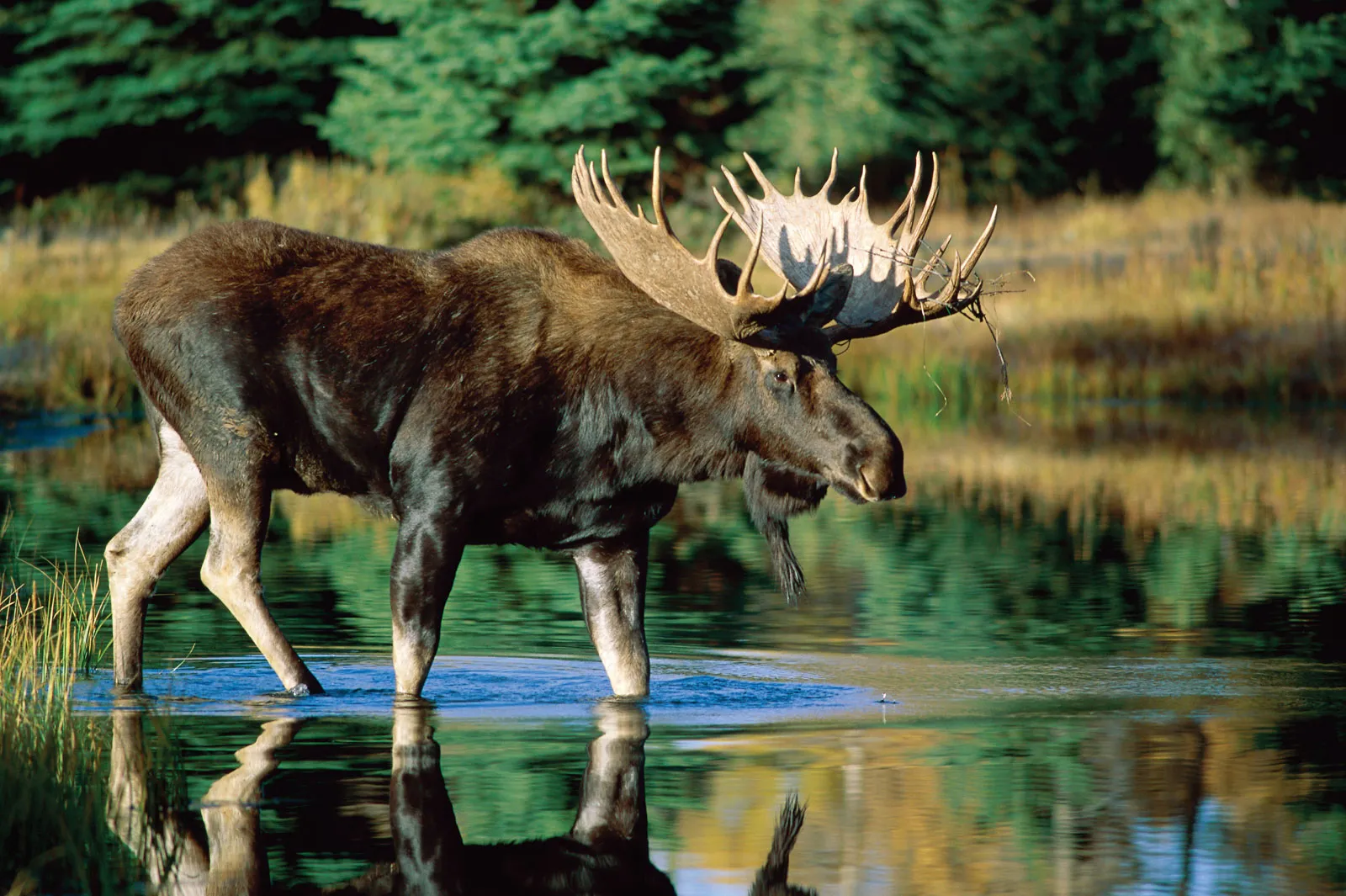
Moose, also known as the majestic giants of the North, are fascinating creatures that capture the imagination of animal enthusiasts worldwide. These magnificent mammals belong to the deer family and are well-known for their impressive size and antlers. Found primarily in the Northern Hemisphere, moose inhabit various habitats such as forests, wetlands, and tundra regions.
In this article, we will delve into the world of moose and explore 19 interesting facts about these incredible animals. From their unique physical features to their behavior and habitat, we will uncover the wonders of these gentle giants. So, grab your binoculars and join us on this adventure to discover the intriguing world of moose!
Key Takeaways:
- Moose are the largest deer species, reaching heights of 6.9 feet and weighing up to 1,500 pounds. Their distinctive antlers can span up to 6 feet across, used for attracting mates and establishing dominance.
- Moose are excellent swimmers and divers, with the ability to paddle through water and plunge to depths of up to 20 feet in search of aquatic plants. They communicate through body language and have a keen sense of hearing.
Facts 1: Moose are the largest members of the deer family.
Moose, scientifically known as Alces alces, hold the title for the largest deer species in the world. These magnificent animals can reach towering heights of up to 6.9 feet (2.1 meters) at the shoulder, with males (bulls) weighing up to 1,500 pounds (680 kilograms).
Facts 2: Moose have distinctive antlers.
One of the most iconic features of moose is their impressive antlers. These antlers, which are exclusive to males, can span up to 6 feet (1.8 meters) across and serve various purposes, including attracting mates and establishing dominance.
Facts 3: Moose are excellent swimmers.
Despite their massive size, moose are surprisingly agile swimmers. They can effortlessly paddle through rivers and lakes, adapting to aquatic environments with ease. Their unique snouts even act as natural snorkels, allowing them to breathe while submerged.
Facts 4: Moose have a specialized nose.
Moose possess a remarkable olfactory system, thanks to their long, drooping nostrils. This enables them to detect scents over long distances, making them adept at finding food and identifying potential threats.
Facts 5: Moose have a diverse diet.
These incredible animals are herbivores and have a wide-ranging diet that mainly consists of aquatic plants, leaves, twigs, and bark. Moose are particularly fond of aquatic vegetation and can often be seen wading in marshy areas in search of a tasty treat.
Facts 6: Moose are social creatures.
Moose are not solitary animals. They often form small groups known as “cow-calf” groups, predominantly consisting of a mother moose (cow) and her offspring (calves). However, during the mating season, males can become quite territorial and may spar with each other to establish dominance.
Facts 7: Moose are found in several regions.
The moose has a wide distribution, inhabiting various regions across North America, Europe, and Asia. They are known by different names in different regions, such as elk in Europe and Eurasia.
Facts 8: Moose are excellent runners.
Despite their massive size, moose are incredibly fast runners. They can sprint at speeds of up to 35 miles per hour (56 kilometers per hour) when necessary, allowing them to quickly evade predators or protect their territories.
Facts 9: Moose have a distinctive call.
Male moose produce a deep, resonant call known as a “bell.” This vocalization is used during the mating season to attract females. The sound can carry over long distances and is often described as haunting and otherworldly.
Facts 10: Moose have an extended gestation period.
Female moose have a relatively long gestation period of around 8 months. This allows their young to develop and be born during the spring or early summer when food sources are abundant.
Facts 11: Moose calves can stand minutes after birth.
One astonishing fact about moose is that their newborn calves can typically stand within minutes of being born. These adorable creatures quickly gain their footing and begin following their mothers on wobbly legs, ready to explore their surroundings.
Facts 12: Moose are excellent divers.
When searching for food, moose are not deterred by deeper water. They are remarkable divers and can plunge down to depths of up to 20 feet (6 meters) in search of aquatic plants.
Facts 13: Moose shed their antlers every year.
Contrary to popular belief, moose do not keep the same antlers throughout their lives. Each year, usually during winter, the male moose shed their antlers, and new ones grow in their place. This process ensures the antlers remain strong and healthy.
Facts 14: Moose are strong swimmers.
In addition to being adept at swimming, moose also have the ability to swim long distances. They can cross wide bodies of water, such as lakes and rivers, in search of food, shelter, or new habitats.
Facts 15: Moose communicate through body language.
Moose rely on various postures and gestures to communicate with each other. They use behaviors like head shaking, ear flicking, and piloerection (raising the hairs on their bodies) to convey different messages, including aggression, submission, or fear.
Facts 16: Moose have a keen sense of hearing.
Moose have highly developed auditory systems, allowing them to detect sounds with incredible precision. This acute sense of hearing helps them stay alert to potential dangers and communicate with other members of their group.
Facts 17: Moose are excellent cold-weather adapted.
Moose have a variety of adaptations that help them survive harsh winters. Their hollow hair pockets provide insulation, and their long legs help them navigate through deep snow. Additionally, they have a specialized ability to slow blood flow to their extremities, preventing heat loss.
Facts 18: Moose have a long lifespan.
In the wild, moose can live for up to 20 years. However, due to various factors like predation, diseases, and habitat loss, their average lifespan is usually shorter.
Facts 19: Moose are a symbol of strength and resilience.
Moose have earned a place in the hearts and minds of many cultures as a symbol of strength, resilience, and majestic beauty. They continue to inspire awe and admiration in those fortunate enough to witness their presence in the wild.
So, there you have it – 19 incredible facts about moose, showcasing their unique characteristics, behaviors, and adaptations. These magnificent creatures truly deserve our admiration and protection.
Now that you’ve learned so much about the remarkable world of moose, share these facts with your friends and family, and spread the knowledge and appreciation for these majestic animals. Let’s continue to preserve and admire the beauty of nature’s creations!
Conclusion
These 19 facts about moose give us a fascinating glimpse into the world of these majestic creatures. From their enormous size to their unique antlers, moose possess many remarkable attributes that set them apart from other animals. Their ability to swim, impressive speed, and incredible sense of smell make them highly adaptable to their environments. Whether you encounter a moose in the wild or in a zoo, observing these magnificent animals is an awe-inspiring experience. Remember to admire these creatures from a safe distance and appreciate the beauty and wonder they bring to our natural world.
FAQs
Q: How big are moose?
A: Moose are the largest species of deer, with adult males, or bulls, weighing up to 1500 pounds and standing over 6 feet tall at the shoulder.
Q: Do moose have predators?
A: Yes, moose do have predators. Their main predators include wolves, bears, and occasionally, mountain lions.
Q: How fast can a moose run?
A: Moose are surprisingly fast runners and can reach speeds of up to 35 miles per hour when running at full speed.
Q: What do moose eat?
A: Moose primarily feed on plant matter such as leaves, bark, twigs, and aquatic plants. They are herbivores and consume a large amount of vegetation daily.
Q: Do moose live in herds?
A: Yes, moose are typically solitary animals but during mating season and in certain habitats, they can form small groups called herds.
Q: How long do moose live?
A: The average lifespan of a moose is around 15 to 25 years, although some have been known to live up to 20 to 30 years in the wild.
Was this page helpful?
Our commitment to delivering trustworthy and engaging content is at the heart of what we do. Each fact on our site is contributed by real users like you, bringing a wealth of diverse insights and information. To ensure the highest standards of accuracy and reliability, our dedicated editors meticulously review each submission. This process guarantees that the facts we share are not only fascinating but also credible. Trust in our commitment to quality and authenticity as you explore and learn with us.


